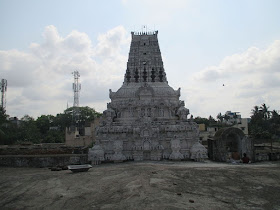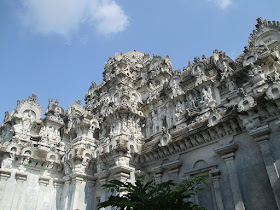Sundaravarada Perumal Temple, Uthiramerur, Kanchipuram
– The Temple
Sundaravarada
Perumal temple covers an area of about 2 acres (0.81 hectares) and has a
five-tiered gopuram
(gateway tower). The temple in enclosed in a rectangular
enclosure with huge granite walls. Unlike other South Indian temples where
there in only one sanctum housing the presiding deity, Sundaravarada temple has
a two storied sanctum and three shrines in cardinal directions around the sanctum.
The
sanctum at the lower level houses the image of Chaturbhujanga Vishnu sported
with four arms. Two of his hands hold the conch and chakra, while the third is depicted with Abhaya
hasta (guarding sign) and the fourth with kati hasta (resting on
thigh). The image is depicted in standing posture and commonly called as the
Sundaravarada Perumal. The sanctum also houses the images of Sridevi and Bhudevi on either sides of Sundaravarada.
The
festival image of Sundaravarada is also housed in the same sanctum. The first
tier is approached by a flight of steps on either side; usually one is used for
ascending and other for descent. The sanctum first tier houses the image of
Vaikuntavarada in seated posture with Sridevi and Bhudevi on either of his
sides. The sanctum is made of wood and has a narrow precinct around the
sanctum. There are shrines of Arjuna, Krishna and Yoga
Narasimha around the sanctum.
Another
set of steps leads to the top floor leading to the sanctum of Ananda Padmanabha
in reclining posture in his serpent bed of Adisesha. The images of Bhudevi and sage Markandeya are seen in the sanctum. The roof of the sanctum
is called Padma Kosthta Ashtanga Vimana, which has sculptural depiction of the nine different
forms of Vishnu.
The
shrine of the consort of Sundaravarada Perumal, Anandavalli, is located to the
south of the main shrine in the lower level. There are smaller shrines of
Lakshmi Narasimha, Rama, Andal, Narasimha and Manavala Mamunigal are found in separate shrines around the first
precinct. The temple tank, called Vairamegha tataka, located to the west of the
temple, is mentioned in a lot of inscriptions.
In the
fore ground, the Shrine of Veera Anjaneya established by Shri Vyasaraja who was
the Raja guru of Krishna Devaraya can be found. Garudalwar Sannidhi is found behind
the kodi maram. All the Vigrahas here are made of wood and hence there is no Abhishekam
only Thirumanjanam with oils.
Structure:
This is
one of the four Vaishnavite temples in Tamilnadu with three tiered Gopurams.
While three Divya Desams - Thiru Koshtiyur (where Ramanuja was initiated the
Thiru Mandiram), Parameswara Vinnagaram (Kanchipuram) and Koodal Azhagar (in
Madurai) have three tiered Gopurams, Sundara Varadar temple in Uthira Merur is
a non - Divya Desam with a three tiered structure. And this one is with a
difference.
While
the other two have only one deity in each of the tiers, this historical temple
has 4 deities each in Tier 1 and Tier 2 and one deity in Tier 3. This is
the only Vaishnavite temple in India with Nine Murthis in a three tier
structure. Hence, this is referred to be a Nava Murthy Sthalam. It was the
belief that Nava Murthis can be installed only where over a 1000 Brahmins
recite the Vedic Parayanam, another indication that Uthiramerur was a hub of
Vedic learning in those days.
Lord
Vishnu is generally seen in any of the 3 forms, Ninraan (நின்றான் -
Perumal in standing posture), Irundaan (இருந்தான் - Perumal in sitting
posture) or Kidandhaan (கிடந்தான் - Perumal in reclining posture like Ranganathar). The
sanctum is built in such a way that all 3 forms of Lord Vishnu are set one
above the other as 3 levels or floors.
First Tier:
This
level houses the main Sannidhi of Sri Sundara Varadhar in the
standing posture (Nindran) facing east. He is accompanied by Sridevi and Bhooma
Devi. There are exquisite paintings behind the main lord in the back ground. This
Perumal was the deity to which Bheema was attached to.
The
outside praharam houses the separate Thayar Sannidhi and the three sides
of the Main temple have Achutha Varadar (prayed by Arjuna) on the Southern
Side, Aniruddha Varadar on the West (behind Sundara Varadar) prayed
by Nakula and Kalyana Varadar on the Northern side prayed by Sahadeva.
It is
believed that those who pray here (with their horoscope) to Kalyana Varadar on
5 consecutive Wednesdays are said to find their life mate immediately. Those
who offer prayers on Tuesdays to Achutha Varadar are said to find jobs
immediately.
Second Tier:
The
second tier houses Vaikunta Varadar in a sitting posture (Irunthan)
(he provided Darshan to Dharmaraja). The outer three sides of the first
tier houses idols of Nara Narayana - (Arjuna and Krishna) on the northern
side. Those who are not able to go to Badri can invoke the blessings of Nara
Narayana at this temple.
Behind
the Vaikunta Varadar is Yoga Narasimha facing west side. It is believed
that those who are not able to climb the several hundred steps at Sholingur can
visit Yoga Narasimha here and the Lord here is said to fulfill the wishes of
the devotees. The fourth idol is Lakshmi Varadar seen here
in Sitting Posture (in Thiruvidanthai one finds Lakshmi Varahar in a Standing
Posture).
Third Tier:
As one climbs
another 10 steps onto Tier 3, one finds Lord Anantha Padmanabha (Lord
Ranganatha) in a sleeping posture atop Adiseshan. Tier 3 presents another
unique feature of this temple - the Dwarapalakas (in this case Dwarapalikas) of
Lord Ranganatha are Goddesses Ganga and Yamuna, not seen in any other
Vaishnavite temple.
He has
an arm on Markandeya rishi and has brahma at his head as well as from his
naabhi. Lakshmi Devi is found kneeling in front with hands as though receiving
a boon. The foot of the Idol shows a standing Shiva with the deer on his left
hand and one small change is that he is shown wearing the Vadagalai Namam.
On this
tier, one finds Vishnu (in sleeping posture), Brahma and Siva inside the
sanctum, the only Vaishnavite temple where one can find the Tri-Murthis inside
the sanctum. Shiva is seen here as an idol and not a lingam, which is another
unique feature at this temple. There are several interesting and colourful
drawings inside the sanctum that gives one an insight into the encouragement
given to artistic work in those days.















































































